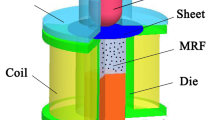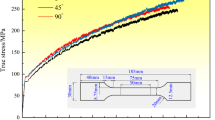Abstract
Flexible medium forming is one of the main processes to manufacture lightweight component of thin-wall sheet metal. The fairing of spherical bottom cylindrical features is an important part of the spacecraft structure. The traditional deep drawing process has some difficulties such as low forming limit, poor wall thickness uniformity, and difficulty in quality control. Compared with the traditional rigid die forming method, the flexible die forming has obvious advantages in producing complex shape members and thin-walled special-shaped members. In this paper, the magnetic medium for transmitting force (MMTF), assisted the deep drawing of pure aluminum spherical bottom cylindrical parts (SBCP), is studied. The research results show that the formability and quality of the SBCP can be improved effectively by using magnetic medium-assisted sheet metal drawing process. When the magnetic field is raised from 0 to 0.2 T, the maximum reduction rate of wall thickness is reduced from 18 to 11.5%. The ability of deformation and coordination and the uniformity on each part of wall thickness are significantly improved. The ultimate forming height is increased by about 11%. And the amount of springback is also greatly reduced. It can be seen that the MMTF-assisted sheet metal drawing process provides scientific guidance and new ideas for the formation of complex shaped members.
Similar content being viewed by others
References
Xu Y, Ma Y, Zhang SH, Chen DY, Zhang XS, Li JM, Zhao CJ (2016) Numerical and experimental study on large deformation of thin-walled tube through hydroforging process. Int J Adv Manuf Technol 87:1885–1890
Koubaa BS, Wali L, Mondher (2017) Numerical investigation of the forming capability of bulge process by using rubber as a forming medium. Int J Adv Manuf Technol 92(5–8):1839–1848
Zhou G, Wang YN, Lang LH (2018) Accuracy analysis of complex curvature parts based on the rigid-flexible hydroforming. Int J Adv Manuf Technol 99(1–4):247–254
Dong GJ, Zhao CC, Cao MY (2013) Flexible-die forming process with solid granule medium on sheet metal. Trans Nonferrous Metals Soc China 23(9):2666–2677
Soeiro JMC, Silva CMA, Silva MB, Martins PAF (2015) Revisiting the formability limits by fracture in sheet metal forming. J Mater Process Technol 217(217):184–192
Isik K, Silva MB, Tekkaya AE, Martins PAF (2014) Formability limits by fracture in sheet metal forming. J Mater Process Technol 214(8):1557–1565
Mitamura Y, Durst CA (2017) Miniature magnetic fluid seal working in liquid environments. J Magn Magn Mater 431:285–288
Oyamada T, Masuda H, Ikari K, Sawada T (2014) Damping characteristics of a magnetic fluid tuned liquid column damper under static magnetic fields. Int J Appl Electromagn Mech 45(1):659–665
Wang YL, Wu YB, Nomura M (2016) Nano-precision polishing of oxygen-free copper using mcf (magnetic compound fluid) slurry. Adv Mater Res 1136:455–460
Merklein M, Rösel S (2010) Characterization of a magnetorheological fluid with respect to its suitability for hydroforming. Int J Mater Form 3(SUPPL. 1):283–286
Wang ZJ, Wang PY, Song H (2014) Research on sheet-metal flexible-die forming using a magnetorheological fluid. J Mater Process Technol 214(11):2200–2211
Li F, Zhou FJ, Wang MN, Zhu SY, Jin CC (2017) New processing research on sheet metal bidirectional pressure forming using a magnetorheological fluid. Int J Adv Manuf Technol 88(1):923–929
Dorfmann A, Ogden RW, Wineman AS (2007) A three-dimensional non-linear constitutive law for magnetorheological fluids, with applications. Int J Non Linear Mech 42(2):381–390
Lang LH, Xu N, Wang YM, Yuan C, Xu YQ, Yang ZH (2013) Research on failure control of hydroforming for thin-walled and deep cavity components. Mater Sci Technol 21(6):1–6
Teng B, Li K, Yuan SJ (2013) Optimization of loading path in hydroforming T-shape using fuzzy control algorithm. Int J Adv Manuf Technol 69(5–8):1079–1086
Funding
This paper was financially supported by the Key Laboratory of Micro-systems and Micro-structures Manufacturing of Ministry of Education, Harbin Institute of Technology (2018KM008).
Author information
Authors and Affiliations
Corresponding authors
Additional information
Publisher’s note
Springer Nature remains neutral with regard to jurisdictional claims in published maps and institutional affiliations.
Rights and permissions
About this article
Cite this article
Liu, Y., Li, F., Li, C. et al. Enhancing formability of spherical bottom cylindrical parts with magnetic medium on deep drawing process. Int J Adv Manuf Technol 103, 1669–1679 (2019). https://doi.org/10.1007/s00170-019-03505-8
Received:
Accepted:
Published:
Issue Date:
DOI: https://doi.org/10.1007/s00170-019-03505-8




